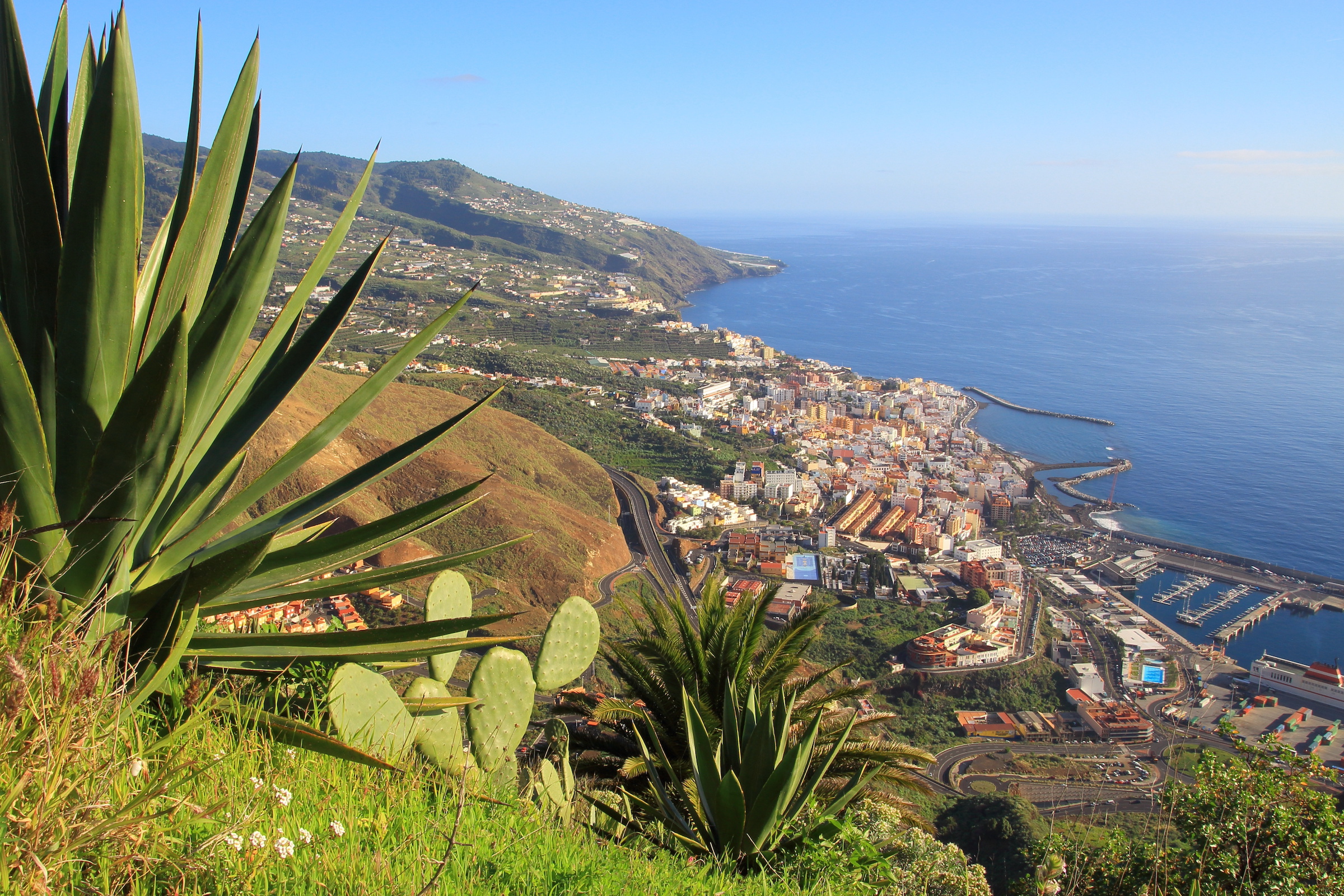The green magic kingdom of the laurel forests
If it rains times on La Palma, which is rather in the northeast more frequently the case and otherwise rather rarely, then the meteorologists have for it an explanation. Actually, the trade wind prevailing there meets resistance on this outermost island of the Canary Islands, because the dry air at high altitudes provides sunshine. But at the same time, a rather humid current rises from lower altitudes, causing clouds to form, from which it drips now and then. To such weather phenomena La Palma owes the lush vegetation in the form of many ferns, laurel forests and huge deposits of ferns. This is a green magic kingdom that extends to heights of almost two thousand meters.
In search of stars and black holes
Those who are drawn to the highest altitudes on La Palma can look forward to a resting place above the clouds and a view of the surrounding islands of the Canary Islands. To the distant Tenerife and to the near neighbors El Hierro and La Gomera. On this island, many thousands of years ago, a catastrophe occurred that created a volcano and also the gigantic Caldera of Taburiente. Los Muchachos, the highest mountain in La Palma, measures 2,350 meters according to official figures. Up there, the air is extremely clear, and since this is also the case at night, numerous European countries have decided to set up top observatories there. Here they look for distant stars or even for the famous "black holes". In order not to cause light smog, the street lamps in the valley are reduced to a minimum of their power.
The waterfall clouds at the edges of the Cumbre
The crater rim is joined by the Cumbre Nueva, which is a weather divide and often offers an impressive spectacle. The air masses moving from the east towards the west form a "waterfall" of clouds kilometers long, because on the west side the humid cargo from the other side of the Cumbre is eliminated by the sun. Just below the crest of this range of hills, the Refugio El Pilar has existed for many years. This is an ever-maintained retreat for the Palmeros, who meet here with all their children for family outings. Under stone houses they barbecue and sizzle, and so that nothing gets out of hand, a ranger watches there until the evening hours. Vacationers are also welcome there and the firewood is free of charge.
On the volcano route through a lunar landscape
El Pilar is also the starting point for a day hike above the clouds. The volcano route is a hit and perhaps the most interesting of the entire Canary Islands. Between five and seven hours should be planned for the way to Fuencaliente. Along the way, the extinct volcanoes become younger and younger. The hikers move in a lunar landscape when they have left the green belt with the last tree tops. Here and there firebreaks have been cut in the pine forest, because La Palma has been hit by fires from time to time in the past decades. However, the mighty pines are largely resistant to fires, because only the bark chars in a fire, and a few months later even those trees are green again, which one would not have expected to recover.
Paths between vines to the lighthouses of Faro
Below the small town of Fuencaliente, which seems a bit sleepy at an altitude of seven hundred meters above sea level, is the youngest piece of Europe, created during the volcanic eruption of the Teneguia in the south of the island, which is almost always battered by storms. In 1971, the last eruption in the Canary Islands took place here, and the lava masses spewed out in the process enlarged La Palma. At the foot of Teneguia, a vast wine country spreads out, and here, on the deep black lava soil, vines thrive for an excellent wine. A paved road and a pleasant hiking trail lead down to the sea and the lighthouses of Faro. A saltworks has been established there, where salt is skimmed from the sea. The products from these salty basins can be bought in supermarkets all over La Palma.
A domicile with sea view is guaranteed
Who decides for a vacation on the "Isla Bonita", can be sure that he booked a domicile with sea view. Because this island rises from the sea in gentle waves over hills and mountains and the houses stretch up to amazing heights, a distant view is guaranteed. The capital Santa Cruz, where there is a small port where cruise ships and the ferry to and from Tenerife dock, looks a bit like it has been stacked on top of each other. It is the metropolis of the east and competes with Los Llanos in the west. Both cities enjoy a character that is typical of them. Santa Cruz is a little more spirited, and a stroll through the pedestrian zone reveals many beautiful patrician houses. Most impressive are the balconies decorated with flowers along the promenade, the Avenida Maritima.
Classical Concerts and the "Santa Maria
Santa Cruz also enjoys a small opera house, the theater "Circo de Marte", where an active organization organizes annual concerts on summer evenings, where now and then even world stars of the scene are lured to La Palma. Palmeros and the so-called residents, i.e. those foreigners who enjoy their permanent residence on La Palma, then listen to the classical sounds in a theater that resembles a somewhat too large dollhouse. Recently, Santa Cruz has had a beach close to town, and there has always been a market hall and the facade of a town hall worth seeing. At the end of the pedestrian area, the replica of Christopher Columbus' legendary "Santa Maria" lies on dry land. However, the America discoverer only ever sailed past La Palma.
Camels operated the scoop wheel of the salt works
Between the port of Santa Cruz and the somewhat too lushly conceived airport of La Palma lies Los Cancajos, a vacation resort of the municipality of Brenja Baja, which has sprung up from the ground. Half a century ago, there was only a small fishing village here and a historic salt works run by the Hernandez Rodriquez family. Formerly, it was camels that drove the large scoop wheel to pump seawater into shallow basins. When no successors could be found, the saltworks were shut down, but since they are of ancient value, UNESCO recognized them as worthy of protection. Today, vacationers from Los Cancajos walk past it along the not very long coastal path.
The evergreen laurel forest of Los Tilos
The stormy north of La Palma leads something like a life of its own. The few roads here lead over countless serpentines, and although the island is just fifty kilometers long, it takes a day's journey if you want to go to Barlovento by rental car. That La Palma was ennobled in its entirety in 2002 as a biosphere reserve, the Isla Bonita owes among other things to its dense and evergreen laurel forest near Los Tilos. This region resembles a primeval forest - with narrow gorges and giant ferns. Waterfalls rush over ridges into the barrancos. One walks there through light and shadow and is always enveloped by the scent of the pine trees. At the latest now the vacationer feels that this island is spoiled by a special flair and is not made for mass tourism.
...and the landlord puts oranges in front of the door
The title "Rural Tourism" was also awarded to La Palma and enjoys increasing popularity among people who in Central Europe would possibly opt for a farm vacation. Several Palmerian families have recognized in it a tourist gap on their island, revived dilapidated buildings to new life and rent them now to vacationers, who can be enthusiastic for a manageable period of time for a life far away from the big roads. They then live in houses with history and in which stories were written. Once, perhaps, the blacksmith of the village worked there, or goats were housed here, under drafty roofs. Every now and then the landlord of these domiciles drops by and places a basket with oranges, bananas or tomatoes in front of his guests.
The boarding house idyll of El Remo
Of course La Palma also has beaches. They are by far not as extensive as on Fuerteventura or at the dunes of Maspalomas on Gran Canaria, but at most bathing bays the Blue Flag flies for clean water and for an acceptable infrastructure. In the west of the island, locals and vacationers alike are drawn to the beaches at Puerto Tazacorte and Puerto Naos, and those who like things a little more rustic climb a ladder into the ocean tamed by the surf there in the boardwalk idyll of El Remo. Safe ocean swimming pools are found in northeastern La Palma with Charco Azul and Piscina La Fajada. If you take a cool dip in Los Cancajos, you're not far from some nice restaurants there.
The quiet days at the end of Europe
On La Palma, however, the vacationer primarily finds nature as a gigantic adventure playground. With hikes in the caldera in the shadow of the Roque de los Muchachos, on the paths between the banana plantations or in the vineyards. Those who have retained a sense of beauty and prefer a vacation off the beaten tourist track should have their hiking boots in their luggage when they fly to La Palma. And he will be rewarded with quiet days on the periphery of Europe.


